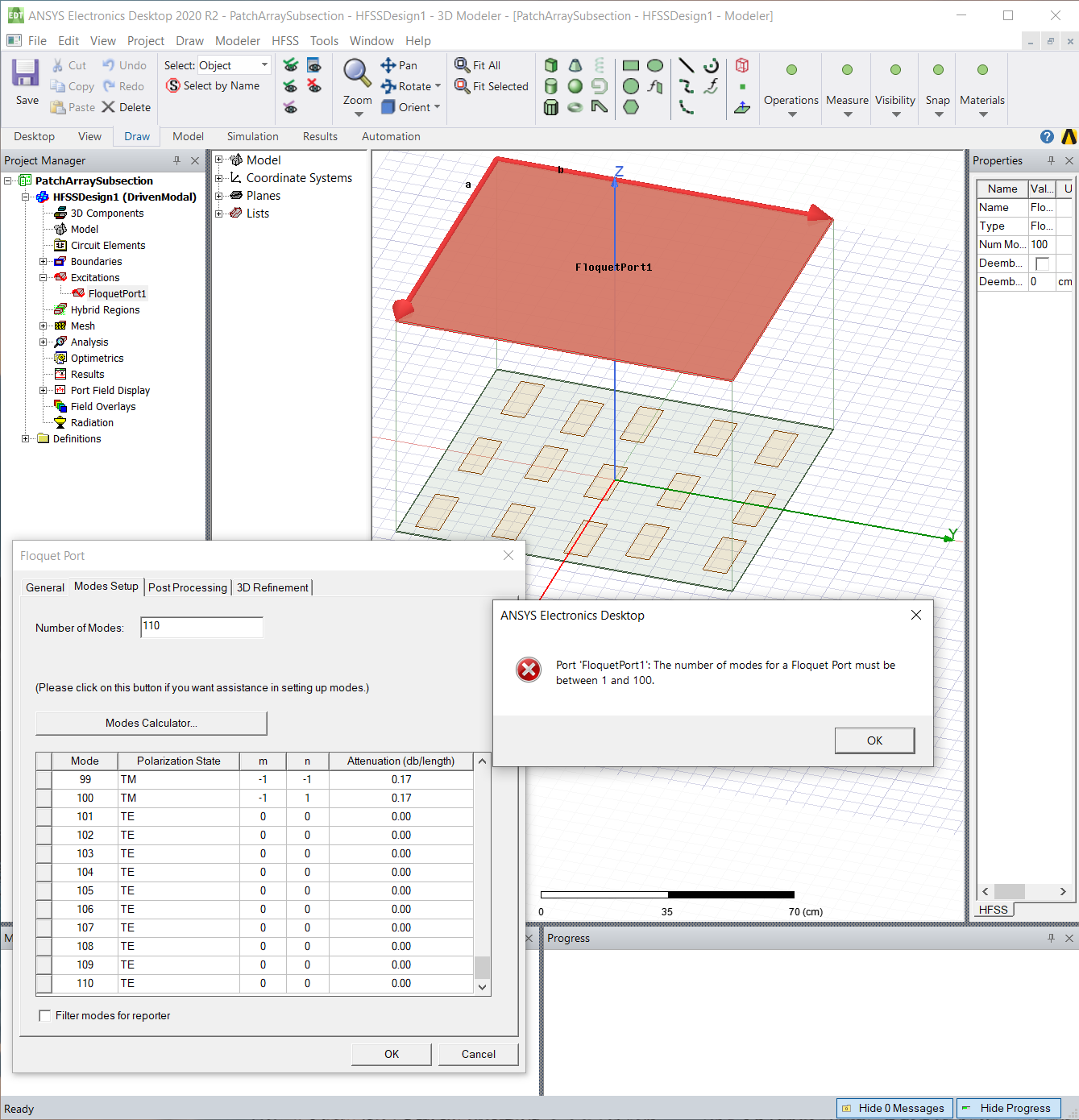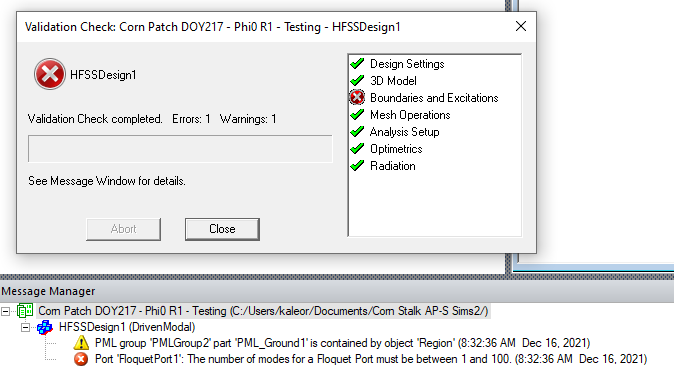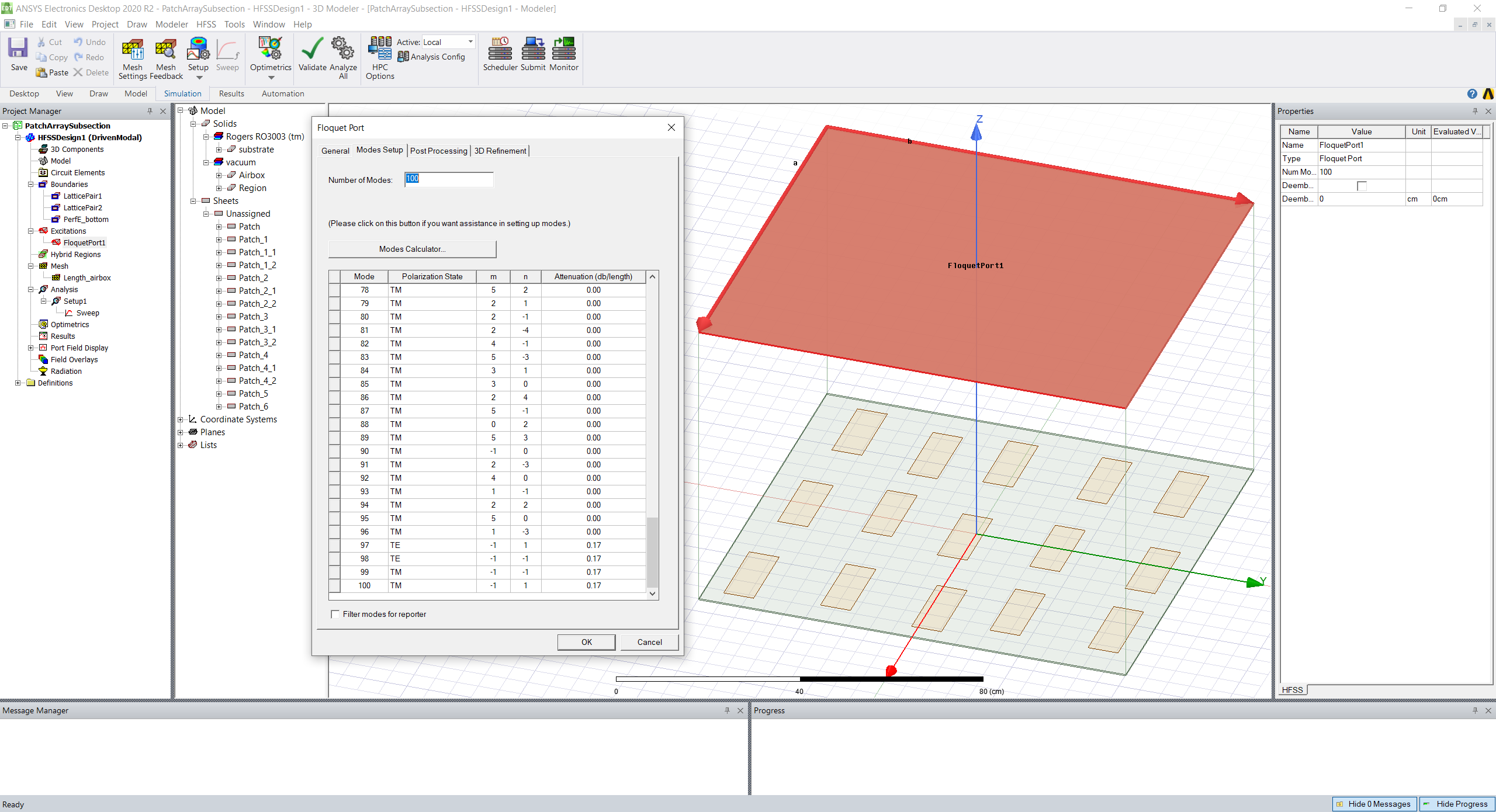-
-
October 25, 2021 at 5:34 pm
kaleor
SubscriberHello,
I am working with a rather large Floquet simulation (90 x 100 cm at 1.25 GHz). I discovered that I can only include 100 Floquet modes max in the Floquet Port dialogue window. I would like to include many more modes in my simulation (perhaps up to 200 total), so I am curious as to why there is a limit on this. Is it because of memory requirements? Does the solution start to become unstable with more modes than 100 or so? I have attached a screenshot of my simulation below.
October 26, 2021 at 2:24 pmPraneeth
Ansys Employee
There is not certain limit on the number of modes supported in Floquet port.
May I know the specific reasons behind why you would like to look at 200 modes?
All the very best.
October 26, 2021 at 3:23 pmkaleor
SubscriberThank you for the response pmunaga!
I do not necessarily want to look at 200 modes exactly, I just know that I probably need a lot more modes than 100 to do what I would like to do. I would like more than 100 modes because I want to calculate the backscatter from a somewhat periodic 2D array of metallic patches. Because of the periodic boundaries I use, energy will only be scattered off the infinite surface (because of the periodic boundaries) in certain directions, or Bragg modes. If I want a Bragg mode in the backscatter direction, then I need to change the size of the unit cell in order to accommodate that. Having a large unit cell (or many Bragg modes) means that I do not need to change the unit cell size as much, relatively speaking.
I am using HFSS in ANSYS Electronics Desktop 2020 R2, and I believe it definitely has a limit on the number of Floquet modes you can use in a Floquet port (see attached image). Is there a newer version of HFSS that does not have that restriction?

November 1, 2021 at 4:22 pmkaleor
SubscriberJust an update on my end here I obtained the most recent version of HFSS (2021 R2). The limit on the Floquet modes still exists in this version. Again, is this because of memory requirements? HFSS's internal solution process? Or algorithm instability?
Thank you!
December 1, 2021 at 11:15 amPraneeth
Ansys Employee
For the Floquet port, the mode calculator can only allow up to 100 modes.
But if you know the attenuation constants for the required modes then you can enter them manually.
Using this way, you can add more than 100 number of modes.
All the very best.
December 16, 2021 at 1:51 pmkaleor
SubscriberHi @pmunaga Thank you for the clarification!
I gave that a try, but I still came up with an error. I added more modes to the Floquet port by editing the .aedt file directly as shown in the image below. I calculated the attenuation constants that I would need for the additional modes.
 I checked to make sure that the new modes registered in the project after I edit the file. They did, and this is shown in the screenshot below.
I checked to make sure that the new modes registered in the project after I edit the file. They did, and this is shown in the screenshot below.
 The error that still came up occurred after I ran the validation check. It complained that I cannot have more than 100 modes specified in the Floquet port.
The error that still came up occurred after I ran the validation check. It complained that I cannot have more than 100 modes specified in the Floquet port.
 Because of that, it seems like there is a hard limit on the number of Floquet modes. Does this limit exist because of limitations of the algorithm used to solve problems with a Floquet port? Or is it an arbitrary limit?
Because of that, it seems like there is a hard limit on the number of Floquet modes. Does this limit exist because of limitations of the algorithm used to solve problems with a Floquet port? Or is it an arbitrary limit?
Thank you!
Viewing 5 reply threads- The topic ‘Why is the maximum number of Floquet modes in HFSS 100?’ is closed to new replies.
Innovation SpaceTrending discussions- Lumped Port Deembed
- HFSS libnvidia-ml.so too old or could not be found – Warning in slurm job output
- Optimizing Via Impedance in Ansys HFSS 3D Layout Using Geometric Parameter Sweep
- Hfss 3D pcb via capped and filled with epoxy
- AEDT Natural Convection with default correlation is failing solver initializatio
- STL Import Errors in HFSS After Cleaning in SpaceClaim
- Three-Phase Voltage Imbalances in dual stator electric generator
- Calc Error in Field Calculator after PyAEDT Analyze
- import file autocad 3d
- Co-simulation in Q3D, Icepak – meshing problem
Top Contributors-
4167
-
1487
-
1363
-
1194
-
1021
Top Rated Tags© 2025 Copyright ANSYS, Inc. All rights reserved.
Ansys does not support the usage of unauthorized Ansys software. Please visit www.ansys.com to obtain an official distribution.
-
The Ansys Learning Forum is a public forum. You are prohibited from providing (i) information that is confidential to You, your employer, or any third party, (ii) Personal Data or individually identifiable health information, (iii) any information that is U.S. Government Classified, Controlled Unclassified Information, International Traffic in Arms Regulators (ITAR) or Export Administration Regulators (EAR) controlled or otherwise have been determined by the United States Government or by a foreign government to require protection against unauthorized disclosure for reasons of national security, or (iv) topics or information restricted by the People's Republic of China data protection and privacy laws.












